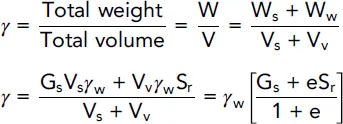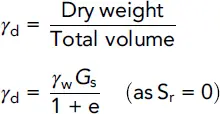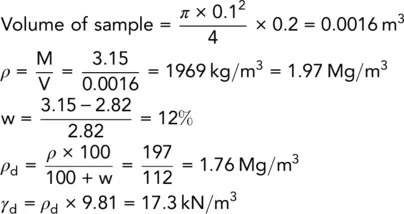Soil weights are usually expressed in kN/m 3.
In soils work, it is generally more convenient to measure the density of a soil through test (e.g. Example 1.8) then to perform the geotechnical analysis using the unit weight, or weight density, derived from the density value.
Density of soil
Bulk density
The bulk density of a soil is a frequently requested, easily determined, geotechnical property. By sampling a soil using a sampler (e.g. a steel tube) of known volume, V, the mass, M can easily be measured on laboratory scales and the bulk density determined:

The bulk density is the density of the wet soil, as it considers the mass of water in the soil as well as the soil particles.
The dry density is the density of the soil particles within the same volume, V as the bulk density.

The dry density can be determined from the bulk density and the water content (in %):
(1.13) 
Unit weight, or weight density, of soil
As mentioned, the unit weight of a material is its weight per unit volume. In soils work the most important unit weights are:
This is the natural in situ unit weight of the soil. Referring to Fig. 1.12and Section 1.7.3:
(1.14) 
Saturated unit weight, γsat

Recall, when soil is saturated, S r= 1. Therefore,
(1.15) 
(1.16) 
Effective, or buoyant, unit weight, γ'
When a soil is below the water table, part of its weight is balanced by the buoyant effect of the water. This upthrust equals the weight of the volume of the water displaced.
Hence, considering unit volume:
(1.17) 
The effective unit weight is also referred to as the buoyant unit weight or the submerged unit weight .
Note : The two terms weight density and unit weight are synonymous, and both are in common use. Both terms are used throughout this book.
Additional expressions for densities
As with the unit weights, similar expressions can be obtained for densities:
(1.18) 
(1.19) 
(1.20) 
(1.21) 
Relationship between density and unit weight values
In the previous expressions, G s, e, S rand the number 1 are all dimensionless.
Hence, a particular unit weight = γ wtimes a constant.
The corresponding density = ρ wtimes the same constant.
Example 1.8Dry unit weight
A sample of wet soil was extruded from a sampling tube of diameter 100 mm in a soil testing laboratory. The length of extruded sample was 200 mm. The mass of the wet soil was 3.15 kg. Following a water content determination, the mass of the dry soil was found to be 2.82 kg.
Determine the bulk density, water content, dry density and dry unit weight of the soil.
Solution:

Relationship between w, γd and γ
(1.22) 
(1.23) 
(1.24) 
Rearranging ( 1.24) and substituting into ( 1.22) gives:

And substituting into ( 1.23) gives:

Thus, to find the dry unit weight from the bulk unit weight, divide the latter by (1 + w) where w is the water content expressed as a decimal.
Relationship between e, w and Gsfor a saturated soil

i.e.
(1.25) 
Relationship between e, w and Gs for a partially saturated soil

i.e.
(1.26) 
Example 1.9 Physical properties determination
In a bulk density determination, a sample of clay with a mass of 683 g was coated with wax. The combined mass of the clay and the wax was 690.6 g. The volume of the clay and the wax was found, by immersion in water, to be 350 ml.
Читать дальше


































